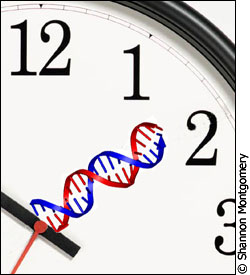| Crossing
the body's time zones
By Shannon Montgomery
OTTAWA — Hotel
front desk clerk Devon Gignac has been working nights
for the past five years, and says it’s now his
way of life.
“It’s not so bad on me, because
I work steady nights, but I find it hard to reset my
clock on the weekend,” he says.
He says that Sunday nights are difficult
because he’s gets back into sleeping nights over
Friday and Saturday so he can do things like grocery
shop during the daytime hours. But besides the occasional
fatigue and the 15 pounds he’s lost since starting
the graveyard shift, Gignac says he hasn’t noticed
any ill health effects from his shift work.
 |
| People working shiftwork
can have a much higher incidence of breast cancer,
diabetes, cardiovascular disease, among other things. |
A new field of research shows that Gignac’s
internal clock may not be faring as well as he thinks,
with a constantly shifting definition of “day."
Genes that can be considered little clocks
are peppered in cells throughout the human body. From
the brain to the skin to the while blood cells, research
has shown that many of the parts of the body contain
cells that oscillate to the rhythm of the solar cycle.
And scientists are beginning to realize
that when these clocks begin to lose time, they can
have an effect on conditions as diverse as cancer, diabetes
and depression.
“If you do mess with a circadian
clock, you do get sick,” says Michael Antle, a
psychology professor and circadian expert at the University
of Calgary.
"There’s a study that came
out of Harvard a number of years ago, they were tracking
nurses who did shift work. And they had a much higher
incidence of breast cancer, diabetes, cardiovascular
disease and a number of other things (as compared to
nurses who worked regular daytime hours)," he says.
 |
| 20,000 clock genes are clustered
in your brain to make a master clock that responds
to light to keep you in sync with the cycle of light
and dark. |
A cell is considered a clock or circadian
cell if it has a steady rotational pattern that lasts
around 24 hours. This pattern starts when clock genes
in these cells code for proteins that slowly build in
the system. Once these proteins have reached a certain
level, they activate a process that works to turn the
original genes off. The level of the proteins then diminish
until they have reached a low enough level that the
genes are switched back on and recommence protein synthesis.
This process is called gene oscillation and it takes
one day in a properly functioning cell.
Around 20,000 of these clock cells are
clustered in the brain to create a “master clock”,
called the suprachiasmatic nucleus (SCN). The SCN is
located in the hypothalamus. The SCN then absorbs light,
uses it to calculate a proper rhythm, and communicates
the time to a number of smaller, “peripheral clocks”
located throughout the body.
“Some of these tissues in the body
can oscillate on their own, but they sort of need the
boss, up in the SCN to tell them how to oscillate, and
tell them when to work,” says Antle.
Clock genes and cancer
The entire system is extraordinarily complicated
and takes place in most of the systems in the body.
This gives many scientists reason to believe that circadian
clocks developed early in the evolutionary process.
“We see that the circadian clock
is present even in the single-celled bacteria,”
says Loning Fu, an assistant professor at the Baylor
College of Medicine in Texas.
| 'If you
talk about cancer connection, cancer is a process
of uncontrolled cell proliferation. And how the
clock can inhibit cancer formation, can prevent
cancer formation, is that the clock gene can directly
regulate cell cycle genes.' |
“Some of these bacteria existed
at least four billion years ago on the earth. So the
circadian clock is kind of an ancient part of our bodies.”
Fu and her colleagues theorize that this
oscillation could have started to protect organisms
from harmful UV rays that hit the earth billions of
years ago at a much more powerful level than they do
today, because the ozone layer had not yet formed.
Early in its history, the "earth’s
surface was naked, it wasn’t really covered. So
the UV radiation from sunlight could be lethal for any
organism. But if an organism could develop a circadian
rhythm, a clock that could gage all sorts of biological
processes, DNA replication could happen at night and
then the organism could acquire an evolutionary advantage,”
she says.
This power that clock genes hold over
the rate of DNA replication has led Fu and other researchers
to stunning findings about the ways in which cancer
forms.
“A previous finding states that
in the mammalian body, the cell cycle proliferation
— the cell dividing from one into two —
takes about 24 hours,” she says.
“If you talk about cancer connection,
cancer is a process of uncontrolled cell proliferation.
And how the clock can inhibit cancer formation, can
prevent cancer formation, is that the clock gene can
directly regulate cell cycle genes.”
Fu’s lab proved this point, showing
that if mice lacked one of the key clock genes, called
Period 2 (per2), they are more prone to developing cancer.
She says that this clock gene also helped
protect against cancer by activating the pathway that
causes cells that have DNA damage to die, keeping them
from mutating — as DNA-damaged cells often do
— into cancerous cells. When per2 was removed,
this pathway wasn’t activated, which meant that
many more cells that suffered DNA damage weren’t
destroyed and became cancerous.
These two findings provide insight into
how cancer can be prevented from occurring in the first
place, Fu says, and they also suggest a better way to
treat cancer that already exists.
As cancerous cells are not properly using
their internal clocks, they proliferate much more quickly
than normal cells, says Fu. This means that it’s
possible to target the cancerous cells with radiation
or chemotherapy at times when they will suffer the most
damage and normal cells the least, based on the clock
cycles of both types of cells.
“Today’s cancer treatment,
you just go to cancer treatment when the doctor’s
available, it’s not that you go to treatment when
your body is best fit to the therapy,” she says.
“So it would be important in the
future to look at the patient and the tumour biology,
and their normal tissue to see the difference. If you
apply the drug when the tumour is more sensitive to
the drug, it can improve the treatment efficiency, and
also at the same time can reduce the side-effects.”
A delicate balance
Research is also beginning to show that
it’s not only disturbing the individual clocks
that can do damage to the body. The body’s peripheral
clocks have a delicate balance in their co-ordination
both with each other and the master clock, and disrupting
this balance can cause just as many problems as disrupting
an individual clock.
At times this can be adaptive, says Atler.
“Part of the idea is that you don’t
need to do the same thing all day long. So you can parcel
you behaviours and your physiological processes into
special little temporal niches, or times of the day,”
he says.
 |
| If the body's peripheral
clocks fall out of sync with the master clock people
end up feeling sick. A mild form of this is experienced
as jet lag. |
“You eat meals at certain times
of the day and your digestive system needs to be active
at those times and you sleep at other times, and you
engage in physical activities at other times. So by
sort of coordinating the systems, you can be ready to
do the things you need at certain times.”
Shimon Amir, a psychology professor at
Concordia University, has studied what happens when
these clocks go out of sync.
“A good example of this is what
happens when you travel across time zones. For example,
when you travel to France from here, the clock has to
advance the phase by six hours because it’s earlier
here than there. Now, when that happens, the master
clock tries to catch up with the new local time, those
other clocks have to catch up as well,” he says.
The clocks become desynchronized as a
result, as the master clock can reorient to new light
cues fairly quickly while all of the peripheral clocks
take longer to reset.
“What you experience as jet lag
is really the result of desynchronization of clocks.
All those gastrointestinal disturbances, emotional disturbances
that you suffer — lousy mood, all kinds of disturbances
in appetite. They are all the result of desynchronization
of circadian clocks in the body,” he says.
Amir says this research has yielded several
interesting tidbits, like it’s easier to adjust
to having your clock delayed than advanced.
“Even in animals, we see when the
phase of the clock is delayed — say we simulate
travel from Montreal to Vancouver — the clocks
catch up much faster than if we put the animal in an
airplane and send the animal to Europe.”
This kind of research could yield better
shifts for people who have rotational hours to ensure
they are always moving in the direction that is easiest
for them to adjust to.
He says his research has also shown that
it’s possible to throw the peripheral clocks out
of sync from the master clock by only targeting them,
and not by changing the master clock at all.
He did this by stressing animals, or inducing
fear. These findings could account for the fact that
people with mental disorders also have disrupted sleep
schedules.
“We know, for example that when
you’re stressed, your circadian rhythms are disturbed,
you suffer from sleep disruption,” he says.
“Or people who suffer from depression
have severe disturbances in their sleep schedules, they
suffer from what is called advanced sleep onset syndrome
— they go to bed very early and they get up really,
really early.”
Not only in rats
Although most of the research done on
clock genes has been done on animals to this point,
it’s slowly becoming possible to look at these
genes in humans.
Nicolas Cermakian at McGill University
is one of the first people to look at these genes in
humans, as part of the Center for Study and Treatment
of Circadian Rhythms. He says his work, with the centre’s
director, Diane Boivin, is “unique in Canada.”
As opposed to his usual work, where he
still works with animals, at this lab the information
about the clock genes come from a more readily available
source.
“In the blood, some of these genes
have an oscillation rhythm,” he says.
| 'The
interesting part of humans is that you can have
humans do stuff that you can’t have animals
do, like simulate jet lag, or stay awake for 36,
48 hours ... You can ask a human whereas you can’t
ask an animal ‘How do you feel?’ after
24-hours of sleep deprivation, which is nice to
know if you’re a pilot, or if you’re
a long-haul truck driver.' |
Francine James, a PhD candidate working
with both Cermakian and Boivin, says it’s not
as easy to study these genes in humans.
“It’s actually pretty hard
to start to get clock genes dosed in humans, because
the advantage of working in animals is you can go right
into the brain and dose the genes, dose the proteins
directly from the clock in the brain, but you can’t
really do that in humans, at least not live ones,”
she says.
But she says any drawbacks to not being
able to peer directly into the master clock are easily
made up for.
“The interesting part of humans
is that you can have humans do stuff that you can’t
have animals do, like simulate jet lag, or stay awake
for 36, 48 hours. Or have them live on a sleep-wake
schedule that isn’t a normal sleep-wake schedule.
So instead of going to sleep every 24 hours, they’d
go to sleep every 40 hours,” she says.
“So then, you can start to look
at more than one thing at the same time. Mostly the
interest with humans is that you can ask a human whereas
you can’t ask an animal ‘How do you feel?’
after 24-hours of sleep deprivation, which is nice to
know if you’re a pilot, or if you’re a long-haul
truck driver.”
The lab began combining clock gene research
with traditional research about five years ago, says
James. But much of that time has been spent making sure
the genes in white blood cells really do oscillate.
 |
| 'We know, for example that
when you’re stressed, your circadian rhythms
are disturbed, you suffer from sleep disruption.' |
The first full-scale human experiment
at the lab to look at clock genes is currently underway
— participants in the experiment are undergoing
sleep deprivation.
Right now, the field of circadian genes
and rhythms is still a new one with a lot of questions
and not many answers.
But the results of these different studies
could end up revolutionizing the way we think about
sleep.
For example, pills that can whisk away
jet lag in an instant may seem like fantasy, but the
University of Calgary’s Antle says he’s
going to begin working on a serotonin/light combination
that seems to reset the body’s clock by eight
hours in one go.
And he says that he’s been constantly
surprised by how complicated all the genes’ interactions
are, making the field full of research that needs to
be done simply to understand it all. For example, he’s
recently shown that the master clock cells — once
considered all the same type of cell — are actually
very diverse with complex communication patterns in
themselves, even before beginning to talk to the peripheral
clocks.
Laughing, he says, “It’s one
of those things that make it so much fun, though.”
|